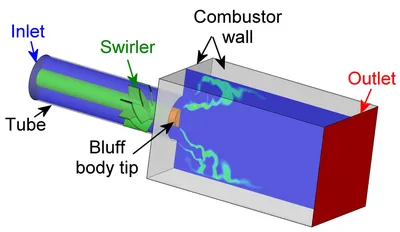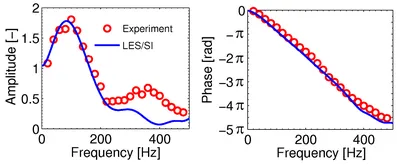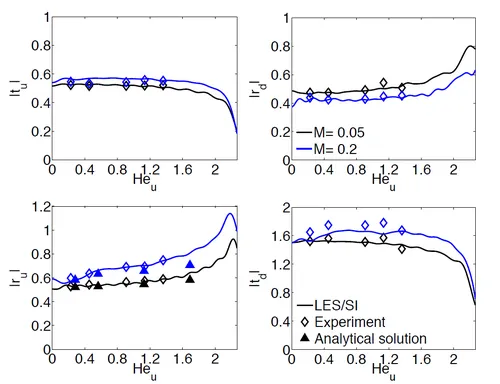Reconstruction of Acoustic Elements Using Large Eddy Simulations and System Identification Methods
by S. Foeller, L. Tay Wo Chong and Wolfgang Polifke
Motivation
The detailed knowledge of the aeroand/ or thermoacoustic transfer behavior of systems under consideration is of vital technological importance. A common approach to determine the stability of a system during the design process is to describe it as a network of acoustic elements. In order to predict the system behavior correctly, the acoustic elements have to be modeled appropriately. Simple elements like ducts can be described analytically. The representation e.g. of the combustion process and of geometries involving complex turbulent acoustic interactions requires advanced numerical methods to determine the acoustic transfer behavior.
The LES/SI method
The LES/SI method combines Large Eddy Simulation (LES) and System Identification (SI) to determine the acoustic behavior of different elements.

Selected Publications
At first, a LES simulation of the acoustic element is conducted in order to take into account the complex interaction of acoustics, fluid dynamics and combustion for example. During a transient simulation, the system is excited with broadband noise, superimposed on the mean flow, while time series of e.g. the pressure, velocity and heat release are extracted for post-processing (Fig. 2,4). The system identification is conducted by analyzing the recorded time series of signals s and responses r. At first, the auto-correlation matrix Γ and the cross-correlation vector c are calculated from these series. Afterwards, the Wiener-Hopf equation is set up and solved with respect to the unknown unitimpulse- response vector h. Finally, a z-transformation of the latter is performed to yield the acoustic transfer behavior of the element in the frequency domain (F(ω)).
Identification of premixed flame dynamics
To analyze the stability of a combustion system, it is necessary to know how the heat release of a flame responds to perturbations of velocity or pressure by the determination of its Flame Transfer Function (FTF). The Flame Transfer Function describes the acoustic properties of a flame in terms of amplitude and phase.
LES/SI methods are used to identify the flame transfer function of a turbulent premixed swirl burner. Taking into account only axial excitation, the system is considered as a Single Input/Single Output (SISO) system. The identified FTF is validated with experiments. The influence of different power ratings, swirler position and combustor wall boundary conditions is investigated.
The LES solver AVBP from CERFACS is used in the simulations in combination with non-reflecting boundary conditions.


Determination of acoustic scattering coefficients in turbulent flows
In linear aeroacoustics the transmission and reflection of plane, harmonic waves in duct systems are completely described by so-called scattering matrices given below

They represent an acoustic Multi Input/ Multi Output (MIMO) system connecting the down- and upstream traveling waves f and g (Fig. 4) via transmission and reflection coefficients t and r, respectively. The latter depend strongly on the geometry, flow velocity, speed of sound and frequency.
The LES/SI method is applied here to determine the scattering coefficients of a cylindrical backward-facing step (Fig. 4).

Results for the scattering coefficients have been determined for different flow conditions (Fig. 5) and show good agreement with analytical solutions and experimental results.
